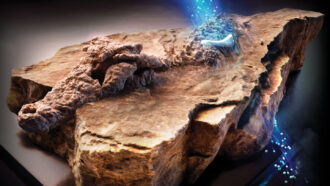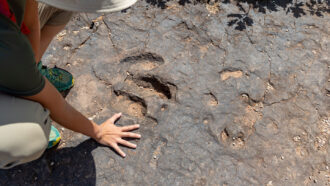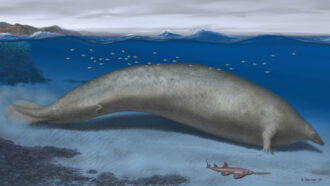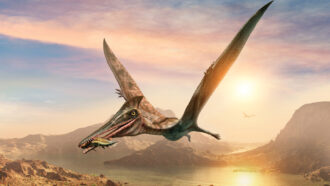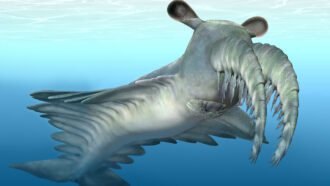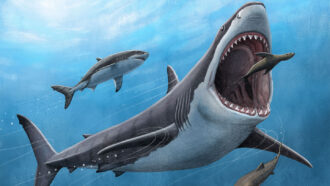Dino-bite!
Study suggests dinosaur's teeth packed poison
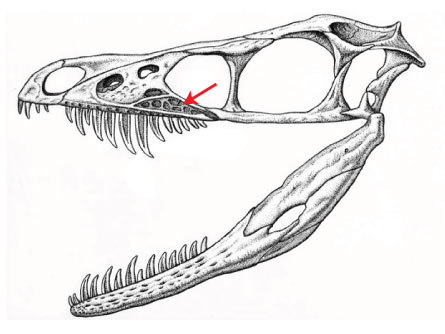
Sinornithosaurus may have overpowered its prey with poison that flowed through grooves in many of the dinosaur’s teeth. The poison, or venom, was probably produced in glands housed in the triangle-shaped depressions on the creature’s upper jaw (red arrow).
National Academy of Sciences
Ten years ago, scientists discovered a well-preserved set of dinosaur remains in China. This dinosaur, which walked on Earth about 125 million years ago, had feathers and was about the same size as a turkey—but don’t be fooled. This dino’s bite was a lot worse than a turkey’s gobble.
After a close (and careful!) examination of the dino’s teeth, scientists recently concluded that this dinosaur was probably poisonous. The study was led by David Burnham, who works and teaches at the University of Kansas in Lawrence.
Burnham is a paleontologist — a scientist who studies fossils to learn about ancient life on Earth. (Fossils include the remains of plants and animals, buried and preserved in the ground.) In this case, Burnham and his team studied three features of the skull and teeth of the dinosaur, which is called Sinornithosaurus. It turns out scientists can learn a lot about ancient animals just by getting them to “open up,” even if they don’t say “ahhhhh.”
First, these paleontologists focused on the teeth in the dino’s upper jaw. In most of those teeth, the scientists observed small grooves that ran the length of the tooth, from the base to the tip. In the past, these grooves contained tiny rivers of poison: Just as the dinosaur bit into its prey, the venom (a kind of “poison”) ran down the groove. Many modern poisonous reptiles have similar features on their teeth.
Also, just above the teeth, in the upper jaw, the scientists observed small pockets in the bone. These pockets probably held special glands that made the venom. A gland is a small organ that makes a substance used in the body. In humans, for example, the pituitary gland is a tiny organ in the brain that produces chemicals needed for growth. In the Sinornithosaurus, the venom gland in the jaw produced poison that was probably stored in reservoirs at the base of the tooth, ready for use when the dinosaur took a bite.
Finally, the scientists noted that several of the teeth were long and narrow. Burnham told Science News that other animals with a similar mix of long and short teeth often use them to bite and hold their prey. And most likely, he says, the poison was used to send the prey into shock. When an animal (or person) goes into shock, it is unable to react to stress — so it can’t get itself out of trouble. Its blood pressure and blood flow may decrease, and parts of the body don’t get all the blood they need.
That’s a lot of information to come from looking at a few bones — without any extra technological tools. By studying the shape and size of the teeth and jaw, the paleontologists were able to learn a lot about how Sinornithosaurus probably ate. Of course, there’s no chance this funky turkey-size dino ever snacked on a human, since dinosaurs and human beings never lived on Earth at the same time.
POWER WORDS (adapted from the Yahoo! Kids Dictionary and other sources)
fossil A remnant or trace of an organism of a past geologic age, such as a skeleton or leaf imprint, embedded and preserved in the Earth’s crust.
prey An animal hunted or caught for food.
paleontology The study of the forms of life existing in prehistoric or geologic times, as represented by the fossils of plants, animals and other organisms.
shock A potentially fatal bodily reaction to a variety of conditions, including illness, injury, blood loss and lack of adequate water, usually characterized by marked loss of blood pressure, decreased blood circulation and inadequate blood flow to the tissues.
gland A cell, a group of cells or an organ that produces and discharges a substance (or “secretion”) for use elsewhere in the body or in a body cavity, or for elimination from the body.
venom A poisonous secretion of an animal, such as a snake, spider or scorpion, usually transmitted by a bite or sting.


